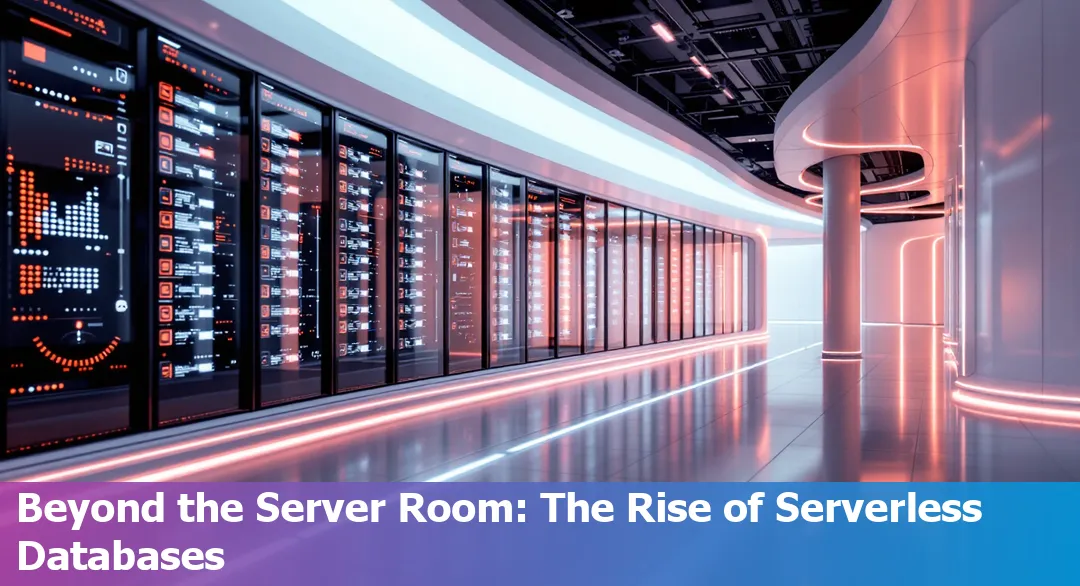Serverless Databases: Are They the Future of Backend Services in 2025?
Last Updated: February 16th 2025

Too Long; Didn't Read:
Serverless databases are transforming backend services by 2025, streamlining development with managed DBaaS solutions that handle scaling and resource allocation automatically. Key benefits include automatic scaling for unpredictable workloads, a cost-effective pay-as-you-go model, and simplified management. Despite challenges like latency and cost management, serverless databases promise enhanced performance and cost savings. With advancements in AI integration and edge computing, they are poised to redefine backend development, with predictions of operational cost reductions and improved application scaling by 2025.
In 2025, serverless databases have revolutionized the way we build backend services. According to recent industry insights, these databases operate as fully managed Database-as-a-Service (DBaaS) solutions, automatically handling everything from scaling to resource allocation.
What makes them amazing is how they've simplified the whole development process - no more stressing about server management or infrastructure setup. AWS's research shows that serverless databases instantly scale to handle thousands of transactions without performance issues, making them perfect for unpredictable workloads.
The best part? You only pay for what you actually use. Developers are loving how they can focus purely on building great applications instead of dealing with backend maintenance.
The tech keeps getting better too, with new features like AI-powered optimization and edge computing integration making everything faster and more efficient. Whether you're working on a small project or scaling up to something massive, serverless databases have become the go-to solution for modern backend development.
They're not just changing the game - they're creating an entirely new playbook for how we build and deploy applications.
Table of Contents
- Key Benefits of Serverless Databases
- Challenges Facing Serverless Databases
- Trends in Backend Development and Serverless Computing
- Future Projections for Serverless Databases
- Frequently Asked Questions
Find out the demand for skills in cloud computing and AI/ML as you plan your backend development career.
Key Benefits of Serverless Databases
(Up)Serverless databases are transforming backend services in 2025 with three major advantages.
- Automatic scaling capabilities allow databases to handle massive transaction volumes without performance drops, making them perfect for apps with unpredictable traffic patterns. When usage spikes, the system instantly adjusts resources to match demand with no manual tweaking required. Learn more about automatic scaling.
- The pay-as-you-go model keeps costs under control by charging only for actual usage. This is huge for smaller companies and startups that need to watch their spending. Research shows that organizations can save up to 90% compared to traditional setups by eliminating the need to pay for idle capacity.
- The third game-changer is simplified management - the cloud provider handles all the tedious stuff like backups, updates, and maintenance. This means developers can spend more time building cool features instead of dealing with infrastructure headaches. Aurora Serverless, for example, automatically handles everything from scaling to high availability, while maintaining enterprise-grade performance.
These benefits explain why more companies are ditching traditional databases - serverless just makes more sense for modern applications that need to be both reliable and cost-effective. The data shows this isn't just hype - it's genuinely changing how we build and run backend services.
Challenges Facing Serverless Databases
(Up)Serverless databases in 2025 face several real challenges that developers need to understand. Cold start latency remains a major hurdle, with response times increasing significantly when functions haven't been used recently.
Recent data shows these delays can stretch from several hundred milliseconds to seconds, seriously impacting user experience. While cloud providers are working on solutions, the issue persists, especially for customer-facing applications that need quick responses.
Cost management is another significant challenge.
The pay-as-you-go model can be tricky to navigate, particularly when dealing with unoptimized queries or unexpected traffic spikes.
While this pricing structure can save money for some organizations, others might face surprise bills if they're not carefully monitoring their usage patterns.
The shift from fixed costs to variable expenses requires a completely different approach to budget planning.
Performance issues can be particularly noticeable with serverless SQL databases, where auto-pause and auto-resume features can add minutes to response times after periods of inactivity. This presents a real problem for applications that need consistent performance. Additionally, not all frameworks and ORMs work smoothly with serverless architectures, forcing developers to either modify their existing code or find workarounds. As more organizations move toward serverless solutions, these compatibility challenges need serious attention from both developers and platform providers.
Trends in Backend Development and Serverless Computing
(Up)The backend development scene in 2025 is seriously transforming, with edge computing becoming foundational rather than just another tech buzzword.
This shift is huge for serverless databases, especially with tools like Cloudflare Workers and AWS Lambda@Edge leading the charge. The stats are mind-blowing - Gartner's saying 75% of enterprise data will be processed at the edge by 2025, which is completely changing how we think about data centers.
The cost savings are massive too - we're talking about a 55% drop in operational expenses.
The tools we're working with in 2025 are next level. What's really interesting is how 40% of larger enterprises are jumping on the edge computing bandwagon, with global spending expected to hit $378 billion by 2028.
FaaS platforms are getting smarter with ML-powered scaling and maintenance. The best part? Developers can finally focus on writing amazing code instead of getting stuck managing servers.
This is making it way easier for smaller companies and startups to compete with the big players, which is pretty exciting for someone just getting into the industry.
These advancements in edge computing, AI integration, and serverless tools aren't just random trends - they're reshaping how we build and deploy backend services, making everything faster, smarter, and more efficient than ever before.
Future Projections for Serverless Databases
(Up)As we look toward 2025, serverless databases are revolutionizing app scalability in ways that honestly blow my mind.
The tech automatically adapts to whatever your app needs - whether it's handling a few users or suddenly scaling up for thousands. By 2025, serverless databases are expected to make apps run 10 times better in terms of scaling, thanks to cloud providers making their systems super smart at resource management.
It's like having an automated assistant that knows exactly what your app needs at any moment.
What's interesting is how serverless and traditional database systems are going to work together in this new tech landscape.
Big companies aren't just throwing out their old systems - they're creating this sweet mix where they use both. By 2025, about 40% of major organizations will be running this hybrid setup, which makes total sense because you get the best of both worlds - the reliability of traditional systems plus the flexibility of serverless.
The real game-changer is how serverless is making everything simpler and faster.
Companies are seeing their operational costs drop by around 20% because they're not dealing with all that complicated infrastructure stuff anymore. Plus, with AI getting integrated into these systems, everything's becoming more streamlined and efficient.
It's pretty amazing how something that seemed so complex before is now basically running on autopilot.
Frequently Asked Questions
(Up)What are serverless databases and why are they significant in 2025?
Serverless databases in 2025 are fully managed Database-as-a-Service solutions that automatically scale and handle resources without user intervention. They have transformed backend development by simplifying infrastructure setup and eliminating server management concerns.
What are the key benefits of serverless databases?
The key benefits of serverless databases include automatic scaling for handling unpredictable workloads, a pay-as-you-go pricing model that controls costs, and simplified management, as the cloud provider handles maintenance tasks such as backups and updates.
What challenges are associated with serverless databases?
Challenges include potential delays in response times due to cold start issues, cost management issues from unoptimized queries and traffic spikes, and compatibility issues with certain frameworks and ORMs, which may require code modifications.
How are serverless databases influencing trends in backend development?
Serverless databases are driving backend development trends by enabling edge computing and AI integration, which enhance efficiency and operational cost savings. They allow developers to focus on building applications instead of managing infrastructure.
What future projections exist for serverless databases by 2025?
By 2025, serverless databases are expected to significantly enhance app scalability and efficiency. Around 40% of major organizations are anticipated to adopt a hybrid approach, combining traditional systems with serverless solutions, reducing operational costs and leveraging AI improvements.
Navigate the complex world of technology selection for backend needs with expert guidance tailored for 2025.
Are you leveraging the latest insights in Availability and Resource Utilization for cost-effective performance?
Explore how efficiency improvements can be achieved through legacy system updates.
Discover the essence of ETL processes and their importance in effective data management strategies.
Understand why microservices architecture is crucial for developing independent, scalable, and resilient global applications.
Discover the enhanced Django ORM features that make it indispensable for modern web projects.
Explore strategies for building resilient multi-cloud pipelines that can withstand the challenges of an ever-evolving tech landscape.
Understand different container runtimes beyond Docker, including Podman and Containerd.
Ludo Fourrage
Founder and CEO
Ludovic (Ludo) Fourrage is an education industry veteran, named in 2017 as a Learning Technology Leader by Training Magazine. Before founding Nucamp, Ludo spent 18 years at Microsoft where he led innovation in the learning space. As the Senior Director of Digital Learning at this same company, Ludo led the development of the first of its kind 'YouTube for the Enterprise'. More recently, he delivered one of the most successful Corporate MOOC programs in partnership with top business schools and consulting organizations, i.e. INSEAD, Wharton, London Business School, and Accenture, to name a few. With the belief that the right education for everyone is an achievable goal, Ludo leads the nucamp team in the quest to make quality education accessible
